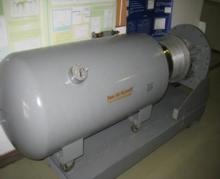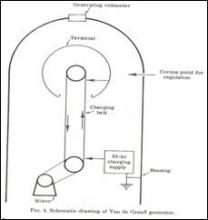Electrostatic or “Van Der Graaf “ generators are very widely used for acceleration of charged particles and, with suitable targets, as neutron sources to energies in the range between 1 and 5 million volts with a precision of somewhat than 0,1%. . The general principles of the belt-charged generator were known in the latter part of the last century but its practical value for nuclear physic was first demonstrated by R.J.Van Der Graaf. The method of operation is illustrated in the next figure. Charge from a 20-or30 Kv supply is sprayed from a row of corona points onto a moving belt which carries it to the field-free region inside a spherical metal terminal. Here, the charge is removed by another row of corona points and flows to the outer surface of the terminal.Early Van Der Graaf generators were operated in air at atmospheric pressure. This required a great deal of space around the terminal and the highest voltages attained were about 1Mv.Today the apparatus is enclosed in a pressure tank and operated at pressure of 10 or more atmospheres. A modern 5-Mev accelerator is enclosed in a pressure tank about 20 ft long and 8 ft in diameter and the structure may have either a horizontal or vertical axis. The positive ions that are usually accelerated are protons and deuterons,hydrogen-3. With a thick beryllium target, the Van Der Graaf generator provides a source of neutrons of either thermal or higher energies. For 3-Mev bombarding energy and a current of 200 μα, about 1012 neutrons/sq cm are obtained. Energies of accelerated particles in Van Der Graaf accelerators can be extended into 10-30 Mev region.


